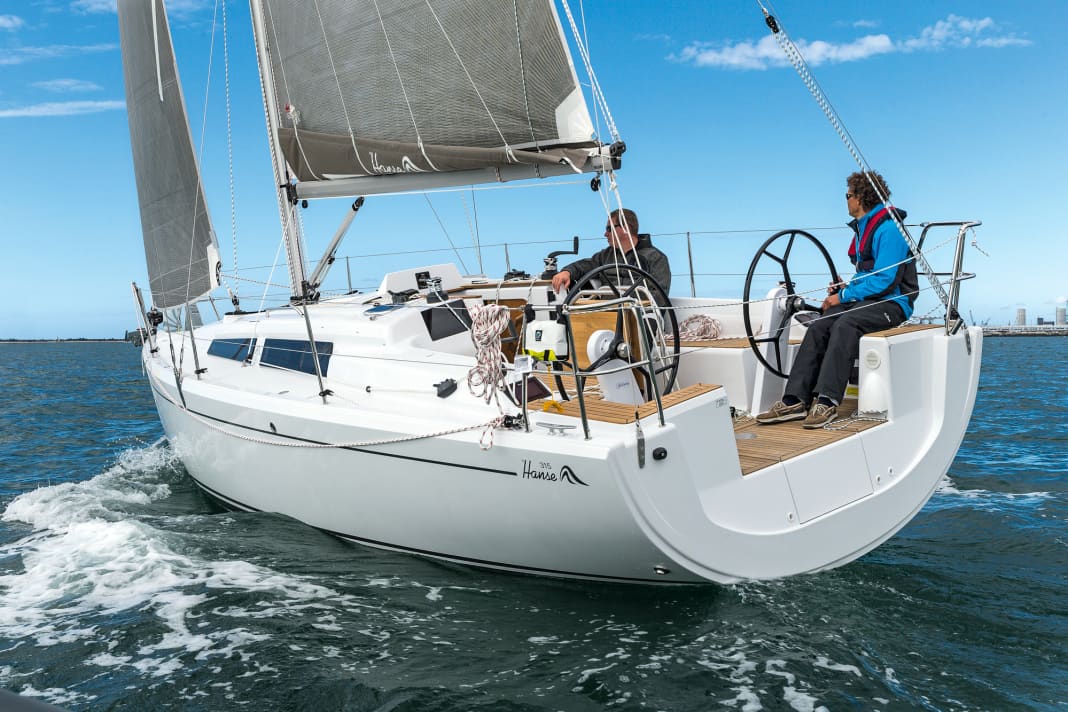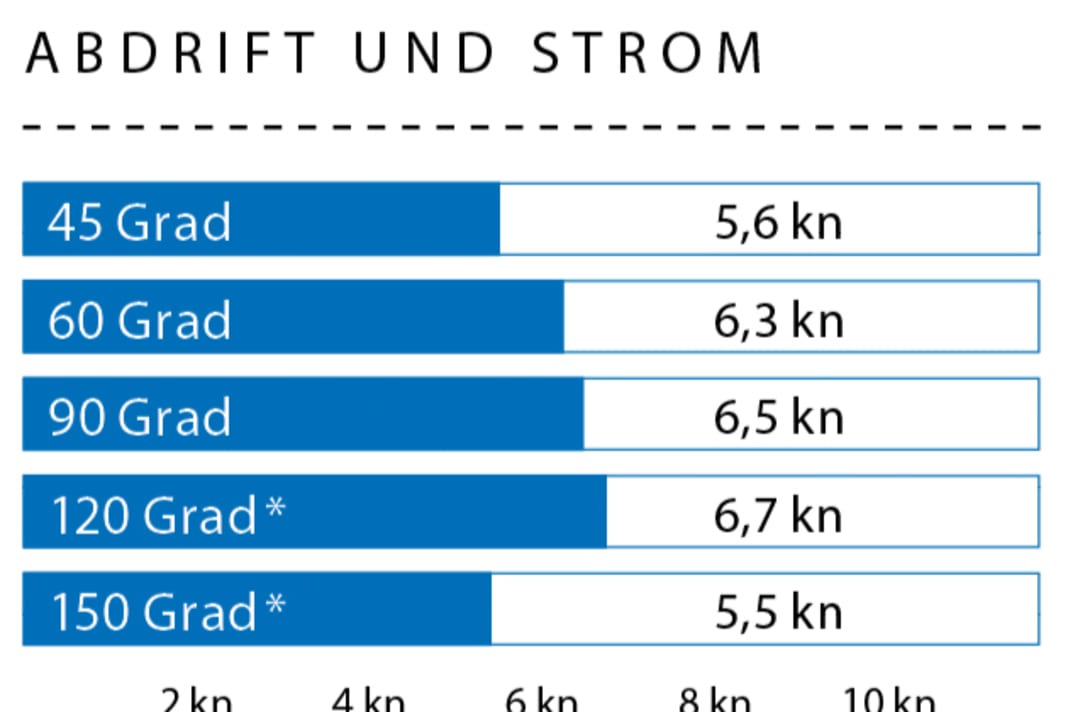





In this article:
There is a lot that the boats in the so-called entry-level class can and must offer: full touring comfort for the family, seaworthiness, easy handling and also good sailing performance. The smallest yachts in the range also have to fulfil representative tasks for their manufacturers - they give newcomers an idea of what the shipyard's larger models are capable of. This is important to get prospective newcomers interested in the brand. On top of that, the cost calculation has to be right. The smaller and simpler the boats, the closer customers look at the pricing.
A distinction needs to be made here, as not all series manufacturers start in the same length segment. Bavaria Yachtbau and Jeanneau, for example, only start their cruising lines at 33 feet, i.e. with a hull length of just under ten metres. Beneteau, Delphia, Dufour and Hanse, on the other hand, start their touring programmes one size smaller, at 31 feet, i.e. just over nine metres in hull length and thus closer to the compact cruiser segment. The new Hanse 315 is even the smallest of all large series cruising yachts.
The key difference is that the smaller boats are still fitted out with two cabins. In the ten-metre class, on the other hand, three-cabin versions are now standard.
Wide and yet handsome
Hanseyachts takes good care of its entry-level yachts with comparatively short revision cycles - this means that the Greifswald shipyard always has a contemporary model in this important segment. With the Hanse 315, another completely redesigned boat is being launched on the market, designed as usual by Hanse's design partners Judel/Vrolijk & Co in Bremerhaven. The newcomer has a strikingly powerful look. This is ensured by the vertically sloping ship ends, the comparatively high freeboard and the compact dimensions. The Hanse 315 is five centimetres wider than its predecessor, the 325, with a slightly shorter hull length.
However, this is only noticeable on the bridge and on paper. Underway, however, the little Hanse presents itself as a very pleasing cruiser with many features that are even sporty to the eye. This is primarily due to the wide, almost semi-circular stern section with the strongly constricted waterline aft - a design feature familiar from Judel/Vrolijk constructions, especially from the current models in the related Dehler series.
Hull of the Hanse 315 as a sandwich construction
With the 315, Hanse is now also building the hull of a small boat as a sandwich construction with a balsa wood core above the waterline for the first time - previously this was only the case for the larger types over 45 feet in length. With this more complex construction method, the shipyard can save material and weight and at the same time present a more robust and thermally and acoustically better insulated hull. The decks of all types are also laminated in a sandwich.
And Hanse is now also fitting the new ship with an L-shaped cast iron keel. A T-keel was and is standard on the predecessor model and also on the larger sisters in the series; L-keels were previously only available as an option in Greifswald. In addition to the standard draught of 1.85 metres with a ballast ratio of 33 percent (1.5 tonnes), a short keel with a draught of just 1.37 metres, but weighing 150 kilograms more, is also available.
For a test, YACHT had construction number 4 at its disposal in La Rochelle on the west coast of France. The conditions: 10 knots of wind on average, plus moderately high swell. The Hanse 315 coped well with this. With the standard self-tacking jib, she achieves 5.6 knots upwind with a tacking angle of around 90 degrees - decent values for a boat of this size and orientation.
The agility on the rudder and manoeuvrability in manoeuvres are above average. The Hanse 315 can be steered excellently upwind on all courses and demonstrates sporty behaviour. The boat's manoeuvrability under engine is also impressive with its apparently very good tuning of the underwater appendages. With the standard Volvo Penta engine, the new boat accelerates both forwards and backwards in a straight line and can also be turned on the disc in the smallest of spaces.
Either - or
Double steering wheels on a 31-foot boat have been a familiar sight at least since the introduction of its most direct competitor, the Dufour 310 Grand'Large, no longer a novelty; now Hanse is following suit. The wide stern still allows a sensible arrangement with two steering positions and thus a clear passage through the appropriately shaped cockpit. Lateral bays allow the helmsman to sit comfortably on the wheel and steer with a good overview. Only the wires from the double backstay get in the way at the back - a familiar annoyance on small boats with an open stern.
Despite all the advantages of the double wheels, they are only available for the Hanse 315 for an extra charge of 3500 euros. The standard boat comes with tiller steering, which makes little sense given the wheel-optimised layout of the cockpit with the very short dents and the wide cut-outs in the aft area. For the version with a tiller, long, continuous dents would undoubtedly be better. However, this would require a second design for the deck, which Hanse does not yet have available. One solution could be flexible modules that are used as a supplement and extend the dents to the stern.
Comfortable touring with the Hanse 315
Other amenities for comfortable touring are also only available as options, for example a folding bathing platform as a stern closure or a table in the cockpit. This means that Hanse is now also following a pricing policy that is now standard for the offers from the large construction series. In concrete terms, this means a favourable basic price for a simply equipped basic package and various options for individual customisation according to personal requirements. To this end, Hanse offers a range of well-assorted equipment bundles for the 315. This can be an advantage for the customer: they receive a boat equipped exactly as they wish, but they can also upgrade later.
The yacht builders from Greifswald asked €71,280 gross for the Hanse at its market launch in 2015 ex shipyard, including the installation machine and a simple set of Dracon sails. Compared to the competition, this was a very attractive and fair offer at the time. Today (as of May 2023), the boat costs 123,640 euros, gross.
More space for sleeping
The ship is a real surprise below deck: it offers significantly more perceived volume inside than you would expect from the outside. Extremely spacious and already widely praised after the first trade fair appearances: the wet room with an easily usable shower area and a headroom of 1.84 metres. Among the competition, only the Dufour 310 can offer similarly comfortable bathroom space.
Unlike the previous model, the aft berth has now been installed transversely. This means there is more space, especially in the foot area, and two people can sleep more comfortably. The more generous arrangement for the bathroom and cabin aft comes at the expense of the storage space in the forecastle; the new 315 only has a volume of around 860 litres available there. For bulky items such as additional sails, for example, space can be tight. In the predecessor model 325, the forecastle box was around twice as large.
The forward berth can be extended to the main bulkhead as required. This means that children can sleep there or even two adults if they use the entire area. Incidentally, the main bulkhead is an option - the cabin is not partitioned off as standard.
The amount of storage space in the foredeck is quite modest, with a lack of side shelves or other storage options, which should be feasible in principle. However, there is more space for larger items such as travelling bags under the benches in the saloon. The storage spaces there are not only ample, but also easily accessible.
Proper work below deck of the Hanse 315
Apart from a few imperfections, such as some gaps that are not quite right, the fit-out below deck is neat and gives little cause for criticism. Hanseyachts saws 17 millimetre thick and additionally coated plywood for the berth boards. And they screw the individual panels to the layers, just like the floorboards in the saloon. Disturbing creaking noises are therefore not an issue.
With the new Hanse 315, the shipyard in Greifswald is offering an attractive, well-rounded and coherent overall package and has thus created an important instrument for presenting itself at the upcoming trade fairs. Small sailing yachts are in vogue, more than ever. Hanse has reacted to this at the right moment: a great job - and perfect timing.
Measured values






Technical data
- Design engineer: Judel/Vrolijk & Co
- CE design category: A
- Torso length: 9,10 m
- Total length: 9,62 m
- Waterline length: 8,70 m
- Width: 3,35 m
- Draught/alternative: 1,85/1,37 m
- Theoretical torso speed: 7.2 kn
- Weight: 4,7 t
- Ballast/proportion: 1,5 t/33 %
- Mast height above waterline: 11,8 m
- Mainsail: 29,5 m²
- Self-tacking jib: 17,5 m²
- machine (Volvo P.): 9 kW/13 hp
- Fuel tank (plastic): 160 l
- Fresh water tank (plastic): 230 l
- Holding tank (plastic): 35 l
Hull and deck construction
GRP sandwich laminate for hull and deck. Full laminate below the waterline. Balsa wood as core material, use of iso-polyester resins, vinylester on the outside
Base price
- 123,640 €, ex shipyard incl. 19% VAT / (as of May 2023)
Shipyard and distribution
- Shipyard: Hanseyachts AG, 17489 Greifswald; www.hanseyachts.com
- Distribution: Dealer network
YACHT rating
Straightforward and appealing entry-level boat from Hanse. The boat impressed in the test with its agile sailing characteristics and is also easy to manoeuvre under engine power. The cockpit layout is designed for double wheels. The interior space is well utilised, but storage space is scarce
Design and concept
- + Attractive overall package
- + Enormous feeling of space below deck
- - Cockpit with tiller inconsistent
Sailing performance and trim
- + Light and agile on the rudder
- + One-handed suitability
- + self-tacking jib or genoa
Living and finishing quality
- +Family-friendly interior fittings
- + Very spacious wet room
- - Little storage space in the foredeck
Equipment and technology
- + Flexible line guidance on deck
- + Adjustable backstay as standard
- - Small baking box
This article appeared in YACHT issue 22/2015 and was revised by the editorial team in May 2023

